


ORGANS OF PARIS © 2024 Vincent Hildebrandt HOME ALL ORGANS
Saint Sulpice
Place Saint Sulpice, 75006 ParisOrgue de tribune OdC >
Chapelle de l’assomption>
Orgue ‘d’étude>


Saint-Sulpice is one of the largest churches in Paris,
only slightly smaller than Notre-Dame. It was built
on the place of a small shrine dedicated to Saint-
Sulpice-des-Champs, which dates back to the 12th
century. It was enlarged in the 14th and 16th
centuries. The construction of a new church begun
in 1646 and was not completed until 1745. The
classic Italian-style façade (1732) was designed by
Giovanni Niccolo Servandoni. The south tower was
never completed (due the the revolution).
The interior decoration of the building is typical of
neo-classical churches with its abundant statuary.
The many works of art were created by the most
talented artists of the time (Jean-Baptiste Louis-
Simon Boizot, Bouchardon, Slodtz brothers). The
remains of Charles Marie Widor lie in the crypt.
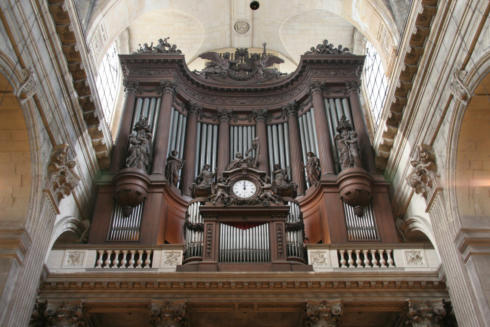

C2
1776-1781
The organ of Saint-Sulpice began to take shape in 1776. Two
designs for the organ case are presented: the first, by the
architect Laurent, where there were no apparent pipes - a
new fashion - and the second, a drawing by Jean-François
Chalgrin. The churchwardens opted for the second project
because, in their opinion, it was more in harmony with the
vast stone gallery built on Servandoni's plans. On January 1,
1778, a contract was signed with master carpenter Jadot
(20,000 pounds) and sculptor Duret (16,000 pounds) for the
making of the organ case. As for the organ, the proposition
was prepared by François-Henri Clicquot and revised by Dom
François Bédos while the contract was signed on January 1,
1780, for the sum of 40,000 pounds.
The organ was completed by Clicquot on April 30, 1781. The
referees appointed were the three organists of Notre-Dame,
Armand-Louis Couperin, Claude Balbastre and Nicolas Séjan,
assisted by Jean-Jacques Charpentier. Dom Bédos, who had
been so passionate about the construction of the
monumental instrument, had been dead for two years. The
official inauguration took place on 15 May 1781 and, in the
face of public interest, a second hearing was held the
following day.
The Clicquot organ had 64 stops, 5 keyboards, a 36-note
pedal and 4,328 pipes powered by fourteen bellows. During
the Revolution, Clicquot's masterpiece was fortunately
preserved.
1834-1845
Restoration of the instrument begun by Louis Callinet in
1834. This organ builder was plagued by financial difficulties
and abandoned the project in 1838.
The restoration of the organ was then entrusted to the
Daublaine and Callinet establishments. The latter did not
complete the work and it was finally the organ builder Pierre-
Alexandre Ducroquet who completed the restoration work.
• Removed multiple rows of full decks
• Added reed stops
•Addition of a Barker machine.
The restored organ was received in April 1846. It had 65
stops.
1855-1863
Following this restoration, neither the parish nor the organist
were satisfied with the instrument. In 1855, they hired
Aristide Cavaillé-Coll to ensure the voicing and maintenance
of the instrument. Almost immediately, Cavaillé-Coll
prepared a project for a complete reconstruction of the
instrument by reusing existing material.
After five years of work, Cavaillé-Coll delivered, in the
Chalgrin case, an instrument with 100 stops, spread over no
less than 7 floors.
The magnificent terrace console brought a great innovation
which consists in entrusting the drawing of the stops to the
Barker machines. This innovation allows, among other things,
to memorize a registration in addition to the stops prepared
with the double layes system.
From the Clicquot organ, he retained about 40 ranks of pipes,
including mixtures and reeds. This is about 2/3 of the original
instrument. He also kept 7 windchests but converted them to
include a second set of valves to optimize the wind supply.
From Callinet, he kept the Trompette en chamade, a few
bassoons and rows of reeds. He also kept the Barker
machine, which he installed on the Récit.
All the mechanics were rebuilt as well as the ventilation and
air supply systems. The latter were equipped with different
air pressures for the bass and treble in addition to having
higher pressures for the reeds than for the bottom stops.
Each division has its own Barker machine while a general
machine is in charge of couplings.
The great organ is distributed over seven floors, from the
floor of the gallery to the vault, at a height of 18 metres (59
ft). Four floors are occupied by the mechanism and the other
three by the pipes.
The inauguration of this monumental organ took place on 29
April 1863 with the participation of César Franck, Camille
Saint-Saëns, Alexandre Guilmant, Auguste Bazille and the
titular organist, Georges Schmitt.
In 1863, a storm pedal, a nightingale and the hail engine
were added at the request of Lefébure-Wély.
1883
The first cleaning was carried out by Cavaillé-Coll himself and
some minor modifications were made mainly to ensure a
better supply of wind to the lower notes of the Récit.
1903
Charles Mutin undertook a major restoration of the
instrument and made changes at Widor's request:
•
small changes in the composition of the instrument: the
Clarinet of the Positif was replaced by an 8' Baritone and
the Euphone 8' of the same keyboard by a 16' Basson.
Three new stops were introduced by exchange: an 8'
Diapason on the Récit, a 2 2/7' Seventh and an 8'
Chamade Trumpet on the Solo keyboard.
•
the order of the keyboards at the console was changed.
While the I Grand Choeur and II Grand-Orgue remained in
the same place, tghe Bombarde's division, placed on the
Third Manual, was moved to the Fifth Manual and took
the name of Solo. The division of the Récit, hitherto on
the Fifth Manual, was transferred to the Fourth Manual.
Finally, the division of Positif, originally speaking on the
Fourth Keyboard, is moved to the Third Manual.
1933
Widor's only criticism was that the Pedal division was still too
small with only 12 stops. To mark his retirement in 1933, the
parish offered him two additional sets for the Pedal, a 16'
and 8' Principal, installed by Pleyel-Cavaillé-Coll, outside the
case on pneumatic chests with purses.
1988-1991
Jean Renaud carried out a thorough dusting of the
instrument, with the utmost respect for its authenticity.
2000
An overhaul by Swiderski.
This organ is an authentic Cavaillé-Coll and one of the few larger
organs of this builder which is NOT electrified! It is a magnificant
instrument, in a church with very good acoustiscs.
Site of the organ
Organiste titulaire
Sophie-Véronique Cauchefer-Choplin & Karol Mossakowski, titulaires du grand-orgue Daniel Roth, titulaire émérite du grand-orgue Louis Jullien, titulaire de l’orgue de choeur Anciens organistes titulaires : Guillaume-Gabriel Nivers (1651 - 1702) J.B. Totin (1702 - ca. 1714) Louis-Nicolas Clérambault (1715-1749) César François Clérambault (1749 - 1760) Evrard Dominique Clérambault (1761 - 1773) Claude Etienne Luce (1773 - 1783) Nicolas Séjan (1783 - 1819) Louis Nicolas Séjan (1819 - 1849) Georges Schmitt (1850 - 1863) Louis-James-Alfred Lefebure-Wely (1863 - 1869) Charles-Marie Widor (1870 - 1934) Marcel Dupré (1934 - 1971) Jean-Jacques Grunenwald (1973 - 1982) Concerts Each Sunday 10 AM organ concert after the mass of 9 AM 10.45 AM Prelude of the mass of 11 AM Regularly concerts on Sundays at 4 PM Masses with great organ Sunday 11.00 AM, 6.45 PM Videos Karol Mossakowski Sophie-Véronique Cauchefer-Choplin Sophie Veronique Cauchefer Choplin Daniel Roth Jean-Jacques Grunenwald Marcel Dupré Audio (Festivo) Sophie-Véronique Cauchefer-Choplin Sophie-Véronique Cauchefer-Choplin Sophie-Véronique Cauchefer-Choplin All organs built before the revolution Photo above: Jeroen de Haan Other photos: Victor Weller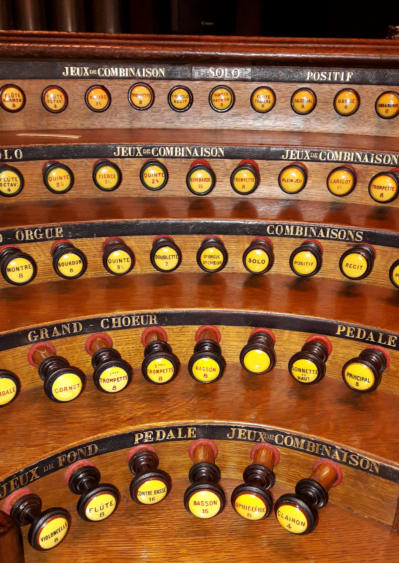

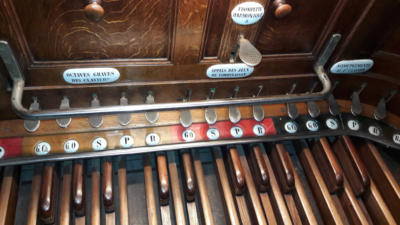
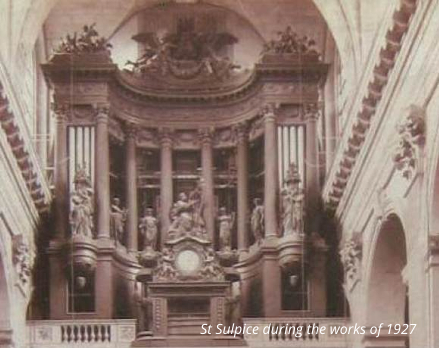
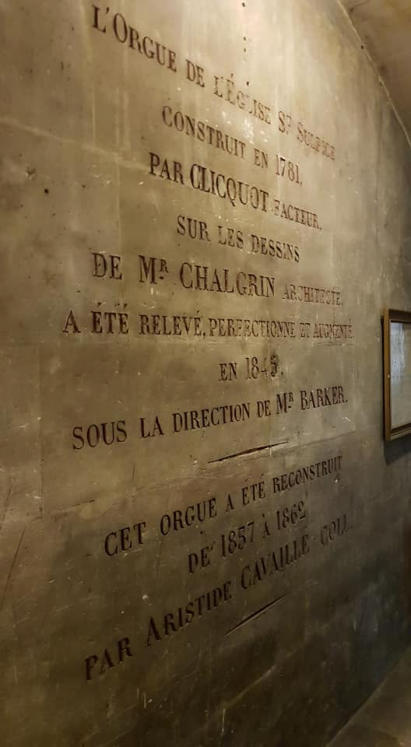
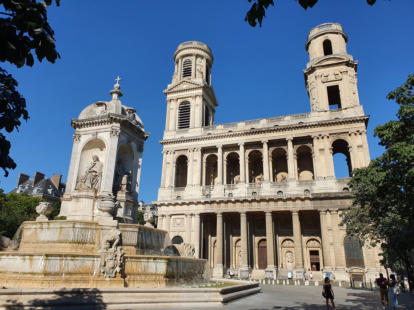
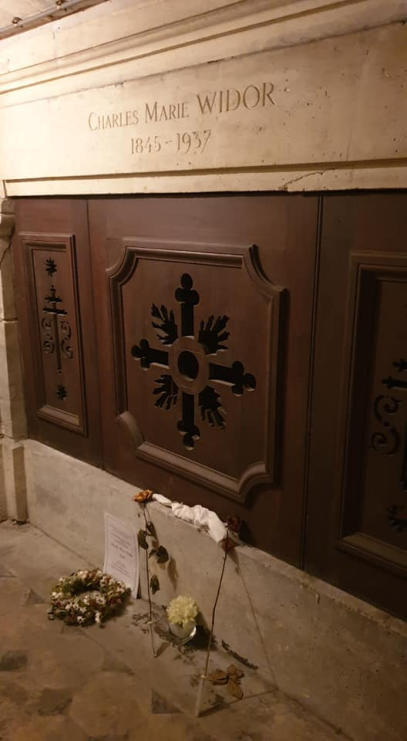
1781 - Clicquot (1)
1834-1845 - Daublaine-Callinet-Ducroquet (5)
1862 - Cavaillé-Coll (3a)
1883 - Cavaillé-Coll (6)
1903 - Mutin (5)
1933 - Société Cavaillé-Coll (2)
1991 - Renaud (5)
2000 - Swiderski (6)
V/102 - traction mécanique
composition
The organs of Paris
Saint Sulpice
Place Saint Sulpice, 75006 ParisOrgue de tribune OdC >
Chapelle de l’assomption>
Orgue ‘d’étude>
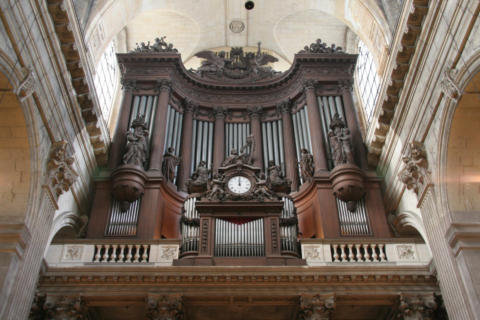
ORGANS OF PARIS © 2024 Vincent Hildebrandt ALL ORGANS
C2
1776-1781
The organ of Saint-Sulpice began to take shape in 1776. Two
designs for the organ case are presented: the first, by the
architect Laurent, where there were no apparent pipes - a new
fashion - and the second, a drawing by Jean-François Chalgrin.
The churchwardens opted for the second project because, in
their opinion, it was more in harmony with the vast stone
gallery built on Servandoni's plans. On January 1, 1778, a
contract was signed with master carpenter Jadot (20,000
pounds) and sculptor Duret (16,000 pounds) for the making of
the organ case. As for the organ, the proposition was
prepared by François-Henri Clicquot and revised by Dom
François Bédos while the contract was signed on January 1,
1780, for the sum of 40,000 pounds.
The organ was completed by Clicquot on April 30, 1781. The
referees appointed were the three organists of Notre-Dame,
Armand-Louis Couperin, Claude Balbastre and Nicolas Séjan,
assisted by Jean-Jacques Charpentier. Dom Bédos, who had
been so passionate about the construction of the
monumental instrument, had been dead for two years. The
official inauguration took place on 15 May 1781 and, in the
face of public interest, a second hearing was held the
following day.
The Clicquot organ had 64 stops, 5 keyboards, a 36-note pedal
and 4,328 pipes powered by fourteen bellows. During the
Revolution, Clicquot's masterpiece was fortunately preserved.
1834-1845
Restoration of the instrument begun by Louis Callinet in 1834.
This organ builder was plagued by financial difficulties and
abandoned the project in 1838.
The restoration of the organ was then entrusted to the
Daublaine and Callinet establishments. The latter did not
complete the work and it was finally the organ builder Pierre-
Alexandre Ducroquet who completed the restoration work.
• Removed multiple rows of full decks
• Added reed stops
•Addition of a Barker machine.
The restored organ was received in April 1846. It had 65 stops.
1855-1863
Following this restoration, neither the parish nor the organist
were satisfied with the instrument. In 1855, they hired Aristide
Cavaillé-Coll to ensure the voicing and maintenance of the
instrument. Almost immediately, Cavaillé-Coll prepared a
project for a complete reconstruction of the instrument by
reusing existing material.
After five years of work, Cavaillé-Coll delivered, in the Chalgrin
case, an instrument with 100 stops, spread over no less than 7
floors.
The magnificent terrace console brought a great innovation
which consists in entrusting the drawing of the stops to the
Barker machines. This innovation allows, among other things,
to memorize a registration in addition to the stops prepared
with the double layes system.
From the Clicquot organ, he retained about 40 ranks of pipes,
including mixtures and reeds. This is about 2/3 of the original
instrument. He also kept 7 windchests but converted them to
include a second set of valves to optimize the wind supply.
From Callinet, he kept the Trompette en chamade, a few
bassoons and rows of reeds. He also kept the Barker machine,
which he installed on the Récit.
All the mechanics were rebuilt as well as the ventilation and
air supply systems. The latter were equipped with different air
pressures for the bass and treble in addition to having higher
pressures for the reeds than for the bottom stops.
Each division has its own Barker machine while a general
machine is in charge of couplings.
The great organ is distributed over seven floors, from the floor
of the gallery to the vault, at a height of 18 metres (59 ft). Four
floors are occupied by the mechanism and the other three by
the pipes.
The inauguration of this monumental organ took place on 29
April 1863 with the participation of César Franck, Camille
Saint-Saëns, Alexandre Guilmant, Auguste Bazille and the
titular organist, Georges Schmitt.
In 1863, a storm pedal, a nightingale and the hail engine were
added at the request of Lefébure-Wély.
1883
The first cleaning was carried out by Cavaillé-Coll himself and
some minor modifications were made mainly to ensure a
better supply of wind to the lower notes of the Récit.
1903
Charles Mutin undertook a major restoration of the
instrument and made changes at Widor's request:
•
small changes in the composition of the instrument: the
Clarinet of the Positif was replaced by an 8' Baritone and
the Euphone 8' of the same keyboard by a 16' Basson.
Three new stops were introduced by exchange: an 8'
Diapason on the Récit, a 2 2/7' Seventh and an 8' Chamade
Trumpet on the Solo keyboard.
•
the order of the keyboards at the console was changed.
While the I Grand Choeur and II Grand-Orgue remained in
the same place, tghe Bombarde's division, placed on the
Third Manual, was moved to the Fifth Manual and took the
name of Solo. The division of the Récit, hitherto on the
Fifth Manual, was transferred to the Fourth Manual.
Finally, the division of Positif, originally speaking on the
Fourth Keyboard, is moved to the Third Manual.
1933
Widor's only criticism was that the Pedal division was still too
small with only 12 stops. To mark his retirement in 1933, the
parish offered him two additional sets for the Pedal, a 16' and
8' Principal, installed by Pleyel-Cavaillé-Coll, outside the case
on pneumatic chests with purses.
1988-1991
Jean Renaud carried out a thorough dusting of the
instrument, with the utmost respect for its authenticity.
2000
An overhaul by Swiderski.
This organ is an authentic Cavaillé-Coll and one of the few larger
organs of this builder which is NOT electrified! It is a magnificant
instrument, in a church with very good acoustiscs.
Site of the organ
Organiste titulaire
Sophie-Véronique Cauchefer-Choplin & Karol Mossakowski, titulaires du grand-orgue Daniel Roth, titulaire émérite du grand-orgue Louis Jullien, titulaire de l’orgue de choeur Anciens organistes titulaires : Guillaume-Gabriel Nivers (1651 - 1702) J.B. Totin (1702 - ca. 1714) Louis-Nicolas Clérambault (1715-1749) César François Clérambault (1749 - 1760) Evrard Dominique Clérambault (1761 - 1773) Claude Etienne Luce (1773 - 1783) Nicolas Séjan (1783 - 1819) Louis Nicolas Séjan (1819 - 1849) Georges Schmitt (1850 - 1863) Louis-James-Alfred Lefebure-Wely (1863 - 1869) Charles-Marie Widor (1870 - 1934) Marcel Dupré (1934 - 1971) Jean-Jacques Grunenwald (1973 - 1982) Concerts Each Sunday 10 AM organ concert after the mass of 9 AM 10.45 AM Prelude of the mass of 11 AM Regularly concerts on Sundays at 4 PM Masses with great organ Sunday 11.00 AM, 6.45 PM Videos Karol Mossakowski Sophie-Véronique Cauchefer-Choplin Sophie Veronique Cauchefer Choplin Daniel Roth Jean-Jacques Grunenwald Marcel Dupré Audio (Festivo) Sophie-Véronique Cauchefer-Choplin Sophie-Véronique Cauchefer-Choplin Sophie-Véronique Cauchefer-Choplin All organs built before the revolution Photo above: Jeroen de Haan Other photos: Victor Weller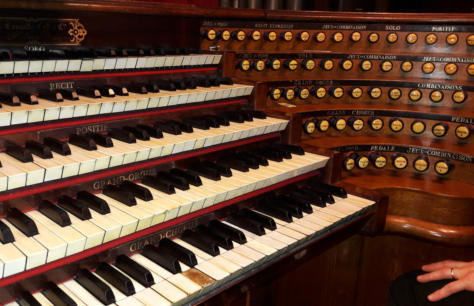
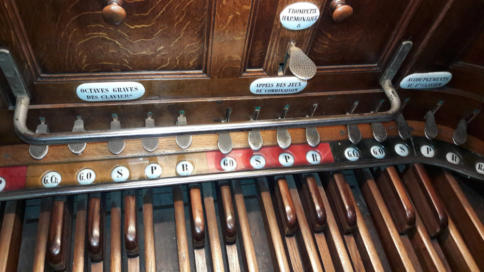
1781 - Clicquot (1)
1834-1845 - Daublaine-Callinet-Ducroquet (5)
1862 - Cavaillé-Coll (3a)
1883 - Cavaillé-Coll (6)
1903 - Mutin (5)
1933 - Société Cavaillé-Coll (2)
1991 - Renaud (5)
2000 - Swiderski (6)






















